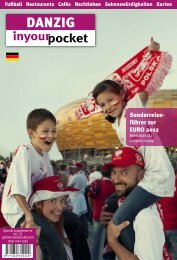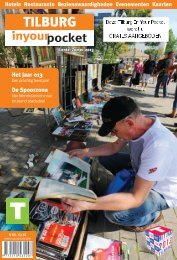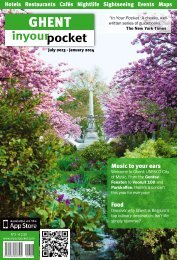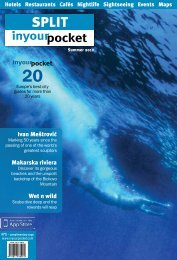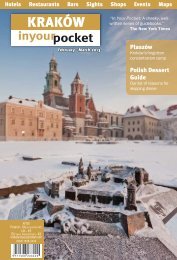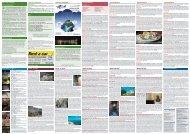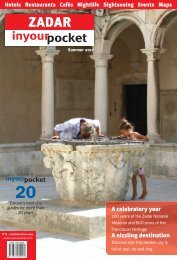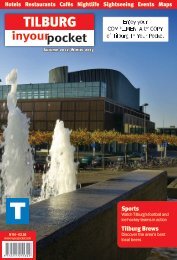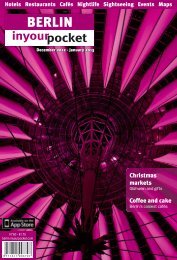7kh 7ul flw\ v prvw dxwkhqwlf 7h[ 0h[ uhvwdxudqw ... - In Your Pocket
7kh 7ul flw\ v prvw dxwkhqwlf 7h[ 0h[ uhvwdxudqw ... - In Your Pocket
7kh 7ul flw\ v prvw dxwkhqwlf 7h[ 0h[ uhvwdxudqw ... - In Your Pocket
You also want an ePaper? Increase the reach of your titles
YUMPU automatically turns print PDFs into web optimized ePapers that Google loves.
66 GDAŃSK WHAT TO SEE<br />
Maritime Museum<br />
Gdańsk’s Maritime Museum is made up of four individual<br />
museums, including The Crane and the Soldek<br />
ship, that together create a complete history of the<br />
port. Straddling both banks of the Motława, tickets<br />
can be bought individually, or you can buy one ticket<br />
for all four museums costing 28/17zł which includes<br />
a free ride on the ferry which sails the short distance<br />
between the Crane and the Museum opposite. You<br />
can save yourself a 10-15 minute walk by using<br />
the ferry even if you are not visiting the museum.<br />
Tickets cost 1zł.<br />
Central Maritime Museum (Centralne<br />
Muzeum Morskie) D-4, ul. Ołowianka 9-13, tel.<br />
(+48) 58 301 86 11, www.cmm.pl. The main part<br />
of the museum is located inside three Renaissance<br />
granaries and if you’ve only got time to visit one of the<br />
three museums this is by far the most comprehensive<br />
of the lot. A complete history of Poland’s nautical<br />
history is represented on several floors and includes<br />
old cannons, huge oil paintings, harpoon guns, a hall<br />
dedicated to underwater archaeology, shipbuilders’<br />
hard hats from the Lenin shipyard, a few pieces of<br />
modern art and an extensive collection of model<br />
ships. <strong>In</strong>formation is available in English. Q Open<br />
10:00 - 16:00. Closed Mon. From July open 10:00<br />
- 18:00. Last entrance 45 minutes before closing.<br />
Admission 8/5zł. Guide tours up to 30 people 35zł,<br />
over 30 people 55zł. Y<br />
NEW<br />
Maritime Culture Centre (Ośrodek Kultury<br />
Morskiej) D-4, ul. Tokarska 21-25 (entrance from<br />
ul. Długie Pobrzeże), tel. (+48) 58 301 86 11, www.<br />
cmm.pl. A brand new building in the shadow of Gdansk’s<br />
crane is the modern setting for the Central Maritime<br />
Museum’s newest exhibition. Spread over 5 floors, kids<br />
will find the ‘People, Ships, Boats’ interactive displays on<br />
the second floor of interest as they learn about the sea<br />
including how devastating tsunamis start while the third<br />
floor is home to a permanent exhibition entitled ‘Boats of<br />
the Peoples of the World (Working Boats)’, which presents<br />
scores of small craft from all over the world, including<br />
Native American dugout canoes, a fabulous little English<br />
coracle and numerous small fishing and trade vessels<br />
from the Far East. The fourth floor currently houses an<br />
interesting temporary exhibition telling the stories and<br />
displaying the treasures recovered from local shipwrecks.<br />
There are plenty of good English descriptions<br />
plus a cafe/restaurant on the fifth floor which offers<br />
great photo opportunities of the river from its terrace.<br />
QOpen 10:00 - 18:00. Closed Mon. Admission 12/8 zł.<br />
Guide tours up to 30 people 35zł.<br />
Sołdek D-4, ul. Ołowianka 9-13, tel. (+48) 58 301<br />
86 11 ext. 327, www.cmm.pl. The first steamship<br />
built in Polish Gdańsk after 1945 at the Lenin Shipyards,<br />
the Soldek has been turned into a living museum. Just<br />
about every inch of the ship can be accessed from the<br />
cramped engine room to the bridge to the pokey little<br />
cabins the crews lived in. The ship was taken off the river<br />
for restoration work, but will be open for visitors again<br />
beginning January 17. Q Open 10:00 - 16:00. Closed<br />
Mon. From July open 10:00 - 18:00. Last entrance 30<br />
minutes before closing. Admission 8/5zł. Guide tours up<br />
to 30 people 35zł, over 30 people 55zł. Y<br />
Archaeology Education Centre - “Błękitny Lew”<br />
(Centrum Edukacji Archeologicznej “Błękitny<br />
lew”) D-5, ul. Chmielna 53, tel. (+48) 58 320 31<br />
88, www.blekitnybaranek.pl. Short of building a time<br />
machine this is the closest you’ll ever get to seeing what<br />
local life was like hundreds of years back. Set in the only<br />
granary building to have survived the bombing of WWII you<br />
can watch a interesting film, available in English showing<br />
the history of the island. Complete with background noises<br />
of peeling bells and animals braying, this museum presents<br />
a series of life-size dioramas designed to show what<br />
Gdańsk once must have been like. Among the recreations<br />
are a cobblers store, a bath house and an inn, and even<br />
the smells have been recreated and piped into the rooms.<br />
The mannequins aren’t exactly Madame Tussaud’s, but<br />
this is still loads of fun, and far removed from the standard<br />
museum experience in Poland. Q Open 09:00 - 17:00.<br />
Closed Mon. From July open 09:00 - 18:00. Closed Mon.<br />
Admission 10/8zł. Family ticket (2 adults, 2 children) 26zł.<br />
Guided tour 60zł. Y<br />
Gdansk History Museum (Muzeum Historyczne<br />
Miasta Gdańska) C-4, ul. Długa 46/47, tel. (+48)<br />
58 767 91 00, www.mhmg.gda.pl. The History of<br />
Gdansk museum calls the impressive Main Town Hall<br />
home, a Gothic-Renaissance structure originally built<br />
in the 14th century and painstakingly repaired following<br />
World War II. <strong>In</strong>side visitors immediately see the ornate<br />
Great Council Hall and Red Hall, the latter of which features<br />
an impressively-sized fireplace and lavish ceilings paintings,<br />
including The Glorification of the Unity of Gdansk.<br />
Subsequent rooms feature vintage 16th and 17th furniture<br />
and a sampling of the museum’s 600 silver pieces, which<br />
highlight Gdansk’s silversmithing era. The top floor of the<br />
museum features a delightful exhibit showcasing what<br />
life was like in everyday Gdansk right before the war -<br />
visitors get a glimpse into the homes and businesses<br />
of residents and see a period in time that was about to<br />
come to an abrupt end. The stairwell back to the main<br />
floor shows what happened to that lifestyle via stunning<br />
photographs of the complete levelling of the city at the<br />
hands of the Red Army. <strong>In</strong> between the old council chambers<br />
and the exhibition showing pre-war Gdansk is where<br />
temporary exhibitions are held. This area was closed as<br />
we went to press but we’re promised that come May 25<br />
the entire museum will be open to the public again with<br />
an exhibition celebrating sport and the achievements of<br />
local sportspeople running until September 30. Q Open<br />
10:00 - 16:00, Tue 10:00 - 15:00, Sun 11:00 - 16:00.<br />
Mon closed. Admission 10/5zł, family ticket 20zł. Tue free.<br />
From June open 10:00 - 19:00, Mon 10:00 - 15:00, Sun<br />
11:00 - 19:00. Admission 10/5zł, family ticket 20zł. Mon<br />
free. From July open 10:00 - 18:00, Mon 10:00 - 15:00,<br />
Sun 11:00 - 18:00. Admission 10/5zł, family ticket 20zł.<br />
Mon free. Y<br />
National Museum Old Art Department (Muzeum<br />
Narodowe Oddział Sztuki Dawnej) B-6, ul.<br />
Toruńska 1, tel. (+48) 58 301 70 61 ext. 233, www.<br />
muzeum.narodowe.gda.pl. Located in a former Franciscan<br />
monastery, the National Museum is a work of art itself<br />
with vaulted ceilings and a large staircase that houses<br />
an impressive collection of equally beautiful objects. The<br />
main draw is Hans Memling’s highly detailed triptych The<br />
Final Judgment, which was returned to Gdansk from the<br />
Russians in 1956 after a circuitous journey through the<br />
hands of Napoleonic troops and Nazis. Paintings showing<br />
pre-destruction Gdańsk and its wealthy residents<br />
are currently off limits as renovation work takes place in<br />
that part of the building but you can still view the work of<br />
Gdańsk <strong>In</strong> <strong>Your</strong> <strong>Pocket</strong> gdansk.inyourpocket.com<br />
Dutch artists in another room. The room of China dishes<br />
is still entirely in Polish, but worth a wander along with the<br />
collections of ceramics, furniture and fabrics that dot the<br />
museum. Q Open 10:00 - 17:00. Closed Mon. From June<br />
open 10:00 - 17:00, Tue 12:00 - 19:00. Closed Mon. Last<br />
entrance 45 minutes before closing. Admission 10/6zł,<br />
family ticket 18zł. Groups over 15 people 6zł per person.<br />
Fri free for permanent exhibitions. Audio guides available<br />
in German and English 13zł. Y<br />
Old Toys Gallery (Galeria Starych Zabawek)<br />
C-5, ul. Ogarna 117/118, tel. (+48) 695 99 53 63,<br />
www.stare-zabawki.pl. The city’s smallest museum<br />
is in essence a room in what was once a shop a block<br />
away from the main street in the heart of the old town.<br />
This, however, is a great example of quality over quantity<br />
particularly if you spent your childhood in the People’s<br />
Republic or are interested in the playthings of children<br />
growing up in the years either side of WWII. It is fascinating<br />
to see both the quality and craftsmanship of hundreds of<br />
re-conditioned toys gathered from donations and house<br />
clearances with many having come from the heartland<br />
of Polish toy making - the region around Czestochowa in<br />
south-west Poland. As with many good collections part<br />
of the enjoyment is garnered from the owners’ pure love<br />
of what they are doing and this is the case here with<br />
the friendly curator happy to give you some background<br />
info on the toys on view which adds to the handy English<br />
explanations available on a series of screens around the<br />
room. While we didn’t grow up in PRL it has to be said we<br />
recognised many of the toys (we in the west just seem<br />
to have had them 10 years earlier) and even at an age<br />
where toys should no longer interest us we still felt a pang<br />
of envy looking at the motor bikes designed for children.<br />
So what that there was a lack of food in the shops - that<br />
lucky boy was riding around on a junior sized motorbike<br />
(we guiltily heard ourselves thinking). This exhibition could<br />
take you 5 minutes or an hour to view depending on your<br />
interest and we can heartily recommend it for a little<br />
look into how young Poles once entertained themselves.<br />
QOpen 10:00 - 18:00. Admission 8/6zł. Groups over 5<br />
people 5zł per person.<br />
Polish Post Office (Poczta Polska) D-2, ul.<br />
Obrońców Poczty Polskiej 1-2, tel. (+48) 58 301 76<br />
11, www.mhmg.gda.pl. Destroyed during WWII and reconstructed<br />
between 1949 and 1951, this still functioning<br />
post office also houses a small museum dedicated to the<br />
events of September 1, 1939 as well as an exhibition of<br />
local postal history from the 18th century to the outbreak<br />
of WWII. Q Open 10:00 - 16:00, Tue 10:00 - 15:00, Sun<br />
11:00 - 16:00. Closed Mon. From June open 10:00 - 19:00,<br />
Mon 10:00 - 15:00, Sun 11:00 - 19:00. From July open 10:00<br />
- 18:00, Mon 10:00 - 15:00, Sun 11:00 - 18:00. Admission<br />
5/4zł. Mon free. Y<br />
Uphagen’s House (Dom Uphagena) B-4, ul. Długa<br />
12, tel. (+48) 58 301 23 71 ext.10, www.mhmg.gda.<br />
pl. This impressive, rococo-style house was built in 1776 for<br />
a Gdańsk merchant family. Now part of the Gdańsk History<br />
Museum, it houses a rich collection of textiles and garments,<br />
displayed in rooms fitted out with mainly original furniture.<br />
English-language boards on the walls describe each room<br />
in detail. Q Open 10:00 - 16:00, Tue 10:00 - 15:00, Sun<br />
11:00 - 16:00. Mon closed. Admission 10/5zł, family ticket<br />
20zł. Tue free. From June open 10:00 - 19:00, Mon 10:00<br />
- 15:00, Sun 11:00 - 19:00. Admission 10/5zł, family ticket<br />
20zł. Mon free. From July open 10:00 - 18:00, Mon 10:00<br />
- 15:00, Sun 11:00 - 18:00. Admission 10/5zł, family ticket<br />
20zł. Mon free. Y<br />
gdansk.inyourpocket.com<br />
GDAŃSK WHAT TO SEE<br />
The Crane<br />
The Crane (Żuraw) D-4, ul. Szeroka 67/68, tel.<br />
(+48) 58 301 69 38, www.cmm.pl. The Crane is<br />
one of the defining symbols of Gdańsk and represents<br />
what little is left of the city’s great trading age. First<br />
mentioned in 1367 the original structure burnt down<br />
in 1442 before its current design was created in<br />
1442-1444. As a working crane it was used to transfer<br />
cargoes and to put up masts on ships. At one time<br />
this was the biggest working crane in the world but<br />
it also served a defence function and as one of the<br />
gates to the city. It had a lifting capacity of 4 tonnes<br />
to a height of 11 metres and this was achieved by two<br />
huge wooden wheels at its heart each with a diameter<br />
of 6 metres. These wheels were originally powered by<br />
men walking inside of them to turn the lifting mechanism.<br />
It remained a working crane until the middle of<br />
the 19th century and was 80% destroyed in 1945 in<br />
the battle for Gdańsk.<br />
After the war it was rebuilt and donated to the Polish<br />
Maritime Museum of which it remains a part today.<br />
You will be able to view a collection of permanent and<br />
temporary exhibitions inside including an exhibition<br />
on port life between the 16th and 18th centuries. <strong>In</strong><br />
Polish only, displays include models of lighthouses,<br />
the old port, life-size recreations of counting houses<br />
and old port life in general plus access to the crane’s<br />
two huge drive-wheels. Q Open 10:00 - 16:00, Sat,<br />
Sun 10:30 - 16:30. Closed Mon. From July open 10:30<br />
- 18:30. Last entrance 30 minutes before closing. Admission<br />
8/5zł. Guide tours up to 30 people 35zł, over<br />
30 people 55zł. Y<br />
May - July 2012<br />
67



